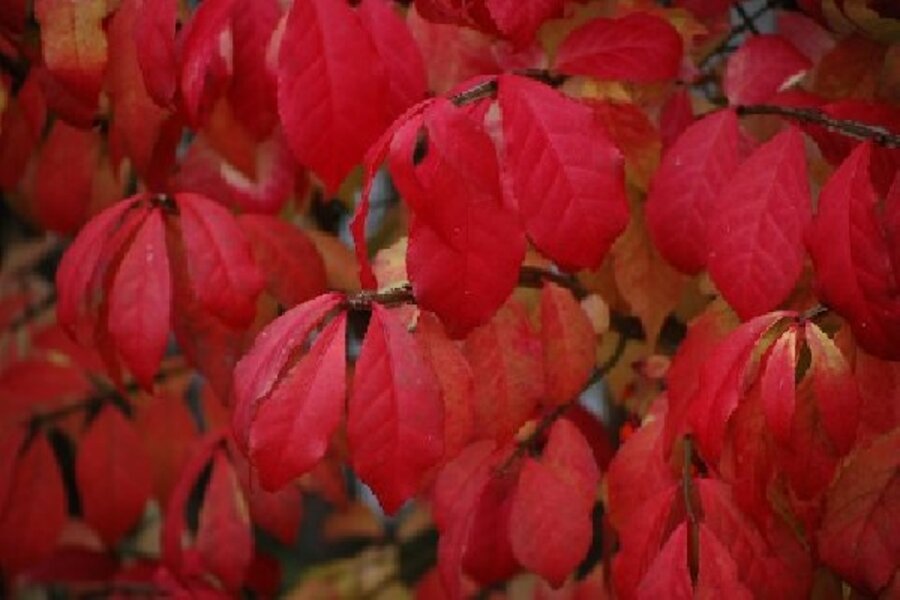Native shrubs for fall color
Loading...
Vermont is a place with a second spring, a time of year when leaves are flowers, to paraphrase the novelist Camus. (Heaven knows we need a second spring, since the first one is widely known as “mud season.”)
But leaf peepers coming by the busload to see our maples, aspens, beeches, birches, and other trees shouldn’t blind us to another source of fall color: deciduous shrubs.
The ubiquitous burning bush, Euonymus alatus is the color champ in the shrub division. Ubiquitous because it’s widely sold and so easy to grow, burning bush has become an invasive plant from the Atlantic coast as far west as Iowa, Missouri and Texas. Its glowing red is seductive, but gird your loins and just say “no.”
Instead of burning bush or Japanese barberry, another botanical bully with alluring fall color, why not consider growing one or two of our native shrubs, plants that know their place in the ecological order of things?
Useful lists of native species are available on online, and there are several first-rate books on the subject, including the brand new Great Natives for Tough Places, the latest Brooklyn Botanic Garden Handbook that deals with native species.
More good news? Many of our natives are as gorgeous as the green immigrants we usually plant, and there are enough home-bred candidates that it’s hard to know where to start or to stop.
My baker’s half dozen would include
- Highbush cranberry, Viburnum trilobum. Cherry-red berries and reddish-purple fall foliage. ‘Wentworth’ has good fruit and fall color; avoid ‘Compactum.'
- Highbush blueberry, Vaccinium corymbosum. Edible blue fruits and red or purple-red leaves in fall. There are many cultivars — ‘Bluecrop’and ‘Jersey’ are good choices. (Plant two or more cultivars to ensure pollination.)
- Oakleaf hydrangea, Hydrangea quercifolia. Large leaves that turn red, orange, and yellow in autumn. ‘Alice’ is an improved cultivar developed by Michael Dirr.
- Red chokeberry, Aronia arbutifolia. Bright red fruits and purple-red leaves in fall. ‘Brilliantissima’ is an improved cultivar.
- Red twig dogwood, or redoiser, Cornus sericea. Dark red stems and leaves in fall. ‘Cardinal’ has especially vivid stems.
-Staghorn sumac, Rhus typhina. Or the smaller but similar smooth sumac, R. glabra. Both species have multicolored leaves — red, yellow, orange — in fall and upright, red fruit clusters.
- Virginia sweetspire, Itea virginica. Red-orange fall foliage. ‘Henry's Garnet’ is widely available.
Some of these autumn dazzlers — highbush cranberry in parts of the Midwest, for example — are now threatened. Adding them to our gardens helps to ensure they will be around forever. Which is as it should be.
Karan Davis Cutler, a former magazine editor and newspaper columnist, is the author of scores of garden articles and more than a dozen books, including “Burpee - The Complete Flower Gardener” and “Herb Gardening for Dummies.” She now struggles to garden in the unyieldingly dense clay of Addison County, Vt., on the shore of Lake Champlain, where she is working on a book about gardening to attract birds and other wildlife. She will be blogging regularly for Diggin’ It.
Editor’s note: To read more posts by Karan, see our blog archive. The Monitor’s main gardening page offers articles on many gardening topics. See also our RSS feed. You may want to visit Gardening With the Monitor on Flickr. Take part in the discussions and get answers to your gardening questions. If you join the group (it’s free), you can upload your garden photos and enter our next contest.





